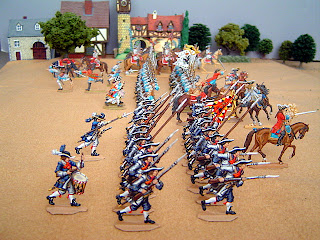More 30mm flats. This is a combination from two Kieler/Ochel sets suitable for the Siege of Vienna in 1683. Interesting that the musketeers are depicted advancing with fixed plug bayonets. The figures are very nicely designed and engraved, I believe the original production dates to the 1920's or so. The pikemen were unpainted castings, the musketeers came in factory paint and tolerably done too but I wanted all the at least be painted to a consistent standard so I stripped and repainted them.
And in battle array.






Good Evening!
ReplyDeleteI have just discovered your blog via EvE .I was fascinated to see the excellent end result you achieved on the flats with arcylics. I have tried a few to no avail. I wonder if you could tell me a little about your technique?
many thanks
Alan
Painting flats ? A topic unto itself. As I see it, there are two ways to go about it: full on connoisseur shading or just get some paint on to field armies quickly (as Tony Bath did). How you approach it depends upon which end of the spectrum you are aiming for. In a way, the contest caliber painters have rather spoiled things for the rest of us mortals as there's (at least in my case) some self-imposed pressure to work to a higher standard when what's needed is something more simply done.
ReplyDeleteSo far as the acrylics go, the main advantage over oils is drying quickly, not to mention those of us from the wargames figures background already have a stock of paints and an established technique. But oils because of their slow drying and composition can be blended in almost infinite gradation. (And if you've never used them, you might be surprised to find they can be painted with more precision as well.)
Not to say that you can't approach these effects with acrylics but it can be difficult. If you squeeze two Vallejo colors out a bottle and mix them, chances are what you get is one intermediate color. This can be mitigated by acquiring artist's acrylics which come in a tube and more closely perform like oils to give a range of coloration when mixed. And a slow drying agent can help.
I you don't plan to shade, don't worry about it. But if you do want to give it a go, keep a consistent imaginary light source regardless of which side you're painting. Start simple: say one base color, one or two darker shade colors, another lighter one for the highlight. Use paintings or other artwork for inspiration and pay attention to how they treat light and shadow. For example, consider a soldier's arm or leg. Treat it like a cylinder, the highlight will fall about 1/3 of the way towards your light source, not right on the edge. Don't be afraid to work boldly with your shading: if you think it's exaggerated, it's probably about right.
Hope that helps more than confuses.....
Best regards,
Steve